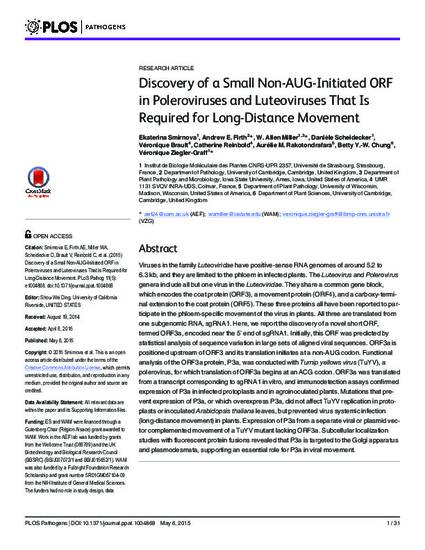
Viruses in the family Luteoviridae have positive-sense RNA genomes of around 5.2 to 6.3 kb, and they are limited to the phloem in infected plants. The Luteovirus and Polerovirus genera include all but one virus in the Luteoviridae. They share a common gene block, which encodes the coat protein (ORF3), a movement protein (ORF4), and a carboxy-terminal extension to the coat protein (ORF5). These three proteins all have been reported to participate in the phloem-specific movement of the virus in plants. All three are translated from one subgenomic RNA, sgRNA1. Here, we report the discovery of a novel short ORF, termed ORF3a, encoded near the 5’ end of sgRNA1. Initially, this ORF was predicted by statistical analysis of sequence variation in large sets of aligned viral sequences. ORF3a is positioned upstream of ORF3 and its translation initiates at a non-AUG codon. Functional analysis of the ORF3a protein, P3a, was conducted with Turnip yellows virus (TuYV), a polerovirus, for which translation of ORF3a begins at an ACG codon. ORF3a was translated from a transcript corresponding to sgRNA1 in vitro, and immunodetection assays confirmed expression of P3a in infected protoplasts and in agroinoculated plants. Mutations that prevent expression of P3a, or which overexpress P3a, did not affect TuYV replication in protoplasts or inoculated Arabidopsis thaliana leaves, but prevented virus systemic infection (long-distance movement) in plants. Expression of P3a from a separate viral or plasmid vector complemented movement of a TuYV mutant lacking ORF3a. Subcellular localization studies with fluorescent protein fusions revealed that P3a is targeted to the Golgi apparatus and plasmodesmata, supporting an essential role for P3a in viral movement.
Available at: http://works.bepress.com/wallen_miller/15/

This article is from PLoS Pathogens 11 (2015): e1004868, doi: 10.1371/journal.ppat.1004868. Posted with permission.